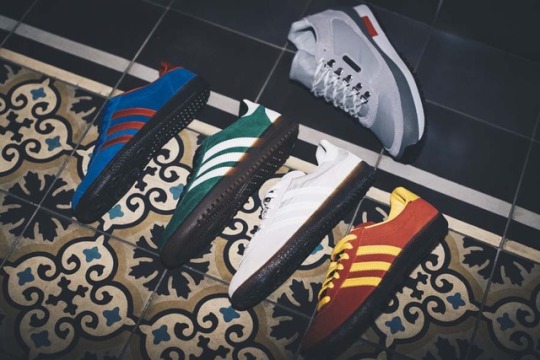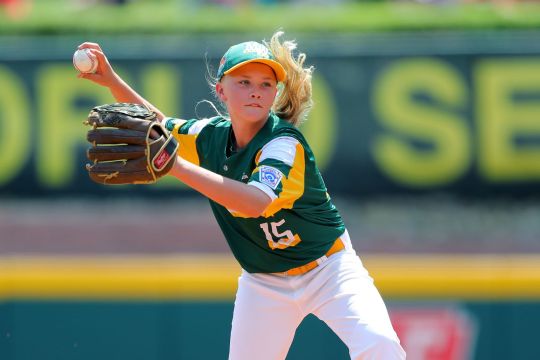#spezial aw'17
Photo


SPEZIAL AW '17 from adidas
This time it’s time for something SPECIAL. adidas new premiere - SPEZIAL AW '17 - is devoted to time - being a reinterpretation of once trendy models - inspired by stylish leisure time - this was called “Freizeit" and was a trend in 70s in Germany - and this is how the sneakers were made! Urban culture was important too, represented by - among others - Goldie - a UK producer, DJ and d'n'b precurssor.
https://sneakerstudio.com/adidas-SPEZIAL-AW-17-blog-eng-1506603388.html
#spezial aw'17#adidas spezial aw'17#adidas Originals GT Wensley Spezial SPZL Clear Brown CG2925#adidas Originals Spiritus Spezial SPZL Scarlet CG2923
1 note
·
View note
Text
Maddy Freking and the history of girls at the Little League World Series

Photo by Alex Trautwig/MLB Photos via Getty Images
Maddy Freking is the latest in a long line of girls determined to play ball.
Media coverage of 12-year-old Minnesota pitcher and second baseman Maddy Freking at the Little League Worlds Series has been predictable, to say the least.
Freking claims the not-altogether-helpful distinction of being the “first girl in five years” to compete in the tournament. What has followed is a slew of well-intentioned but ultimately cliche stories that emphasize how unusual it is for a girl to be playing baseball — did you notice her long blonde hair sticking out from beneath her baseball cap?
Freking has though she’s fielded the repetitive questions with grace. “It’s an honor — I also think it’s really cool to be, out of however many boys have been here, only the 19th girl,” she told ESPN. Yes, 19 girls have played in the Little League World Series. Double digits. She’s the sixth girl to pitch, following Mo’ne Davis’ star turn in 2014.
No, girls don’t play every year, and yes, she’s the only girl currently competing. But her presence begs the question: when do we stop counting?
Girls and women have played baseball roughly since the sport’s genesis in the mid-19th century. Little League was founded in 1939, just four years before the All-American Girls Professional Baseball League was organized (and eventually immortalized in A League Of Their Own). In 1950, then-13-year-old Kathryn “Kay” Johnston-Massar disguised herself as a boy to join her local Little League team in upstate New York; less then a year later, Little League explicitly forbade girls from playing in what became known as the Tubby Rule, dubbed for her gender-bending alias.
The Tubby Rule lasted until 1974 when, on the heels of Title IX, a coalition of girls around the country sued Little League for the right to play. New Jersey’s Maria Pepe, then 12, was the first, aided by the National Organization for Women. Little League came to face nearly 20 lawsuits from girls trying to get on the diamond, and eventually had no choice but to acquiesce.
This is an extremely brief and superficial history of girls in Little League, a small part of their rich history in baseball. Plenty of girls and women play the sport today. Maybe someday, if she keeps it up, Maddy Freking will join the wildly talented U.S. Women’s National Baseball Team, who compete internationally despite having next to no local support.
Below are the 18 girls who preceded Freking at the Little League World Series. This list will likely be out of date within a year or two, and hopefully can eventually stop being maintained at all.
Victoria Roche, Brussels, Belgium (1984)
Roche, 12, was a reserve outfielder for Brussels who played alongside her brother. Her team, the winners of the European championship, was eliminated early in the tournament. Her lack of production as a pinch-hitter (one walk, two hitless plate appearances) was studiously noted by the press, as was the attention her appearances received.
“Victoria is a very spirited girl,” team manager John Fader told the AP. “We’re happy to have her with us. Having a girl on our team has been no problem.”
Roche stayed at a motel in Williamsport away from her team since there were no Little League facilities for girls. “She’s no schlepper — she made it ahead of nine boys,” Fader added later.
“We were watching me on TV last night — it was pretty awful,” Roche told the AP. “I’d rather be just like the other boys.”

Photo from the Burlington Free Press, August 22, 1984
Victoria Brucker, San Pedro, California (1989)
The 12-year-old first baseman was the first American girl to reach the reach the Little League World Series, and entered the tournament as her team’s leading home run hitter despite the fact that she was taken last in the league’s regional draft.
Sexism followed her to the tournament, naturally. In a feature previewing her appearance, the Los Angeles Times described her as a “tall, attractive 12-year-old with darting brown eyes.” For her part, Brucker insisted over and over that she was “just one of the players.”
“When she first started playing, one parent, a man, told me to my face that I should take Victoria home and teach her to cook and clean,” her mother told the paper (she’s described as “a spirited woman”). “I told him, ‘She not only knows how to cook and clean, she can also crochet and play baseball better than your son.’”
“They just pitch her fastballs and she hits them out,” her teammate Anthony Pesusich told the AP. “They think, she’s a girl, so they just pitch fastballs.”
The same year, Betty Speziale became the first woman to umpire a Little League World Series game. The “firsts” piled up as Brucker got the first LLWS hit by a girl, eventually earning three runs (two off walks). But when Brucker’s team lost in the semifinals, her manager told the Times that the pressure and attention (Johnny Carson and Regis Philbin were among those asking for her to come on their shows) had “messed with her head.”

Photo from the Courier-Post, August 22, 1989
Kelly Craig, Trail, British Columbia (1990)
The third girl to play and the first girl to start a Little League World Series game as a pitcher, 12-year-old Craig was pulled in the first inning after three batters got on base. All of her individual errors were scrupulously documented by the national press, unlike those of her male teammates.

Photo from the Central New Jersey Home News, August 21, 1990
Giselle Hardy, Dhahran, Saudi Arabia (1991)
“She’s gutsy. She’d probably chew tobacco if you’d let her,” Hardy’s team manager Rich Hunter told USA Today. Otherwise, the 12-year-old’s team got more attention for playing shortly after U.S. troops established a base in Saudi Arabia than for her participation. Dhahran didn’t go far in the tournament, but Hardy did score a run.

Photo from the Hartford Courant, August 24, 1991
Krissy Wendell, Brooklyn Center, Minnesota (1994)
Wendell was her team’s catcher (the first girl to play in the Little League World Series at the position, are you sensing a pattern?), and the daughter of manager Larry Wendell. He would even let her call pitches, according to a piece from the Pioneer Press. “
She’s a little embarrassed by the attention of the boy-girl thing,” her father told the Washington Post. “I think she just wanted to play well and be part of the team.”
“Some players on other teams don’t think she can be good because she’s a girl,” an opposing pitcher told the Press. “Then they find out otherwise.”
Though coverage still dwelled on Wendell’s diminutive stature and “long blonde hair,” she made her ambitions clear. “I want to be the first female to play in the NHL,” she told the Press. “I like hockey because you’re always playing — there’s always action and there’s roughness.” Wendell became a marquee player on the U.S. women’s national hockey team, eventually becoming captain and leading the squad to its first gold medal at the women’s world championships, where she earned MVP.

Photo from the Philadelphia Inquirer, August 25, 1994
Sayaka Tsushima, Osaka, Japan (1998)
Centerfielder Tsushima was described the first girl to play in the Little League World Series from a “Far East” team (...), and became the first girl to make it to the World Series finals. Her team lost to Toms River East, New Jersey (and, as all the papers noted, she went 0-3).
“I just really want to do my best,” Tsushima told the New York Post through an interpreter. In her team’s first game against the defending champions from Mexico, she earned two runs off a single and a walk. “Being the first girl in a championship game here really doesn’t matter to me,” she continued. “I dream about being a major-league player. But there are a lot of limitations because of being a female.”
Alicia Hunolt, Ramstein Air Force Base, Germany (1999)
Hunolt’s team was eliminated early in the tournament, which might explain why there was little coverage related to how she was the only girl competing. She would later play softball for Auburn.
Tatiana Maltseva, Moscow, Russia (2001)
The reserve catcher was the first Russian player to compete in the LLWS, and, according to her coach, too shy to be interviewed at the time.

Photo from the Democrat and Chronicle, August 17, 2001
Sanoe Aina, Waipahu, Hawaii (2002)
“She’s just one of the guys,” Waipahu coach Delbert Macanas told the AP of Aina, who aspired to be the first girl to win a LLWS title. “The coaches selected her as a co-captain because of her leadership qualities. Sanoe is a great athlete who provides power in our lineup and has a big influence over the other players.”
Unfortunately, Aina’s team didn’t make it to the title game. “Baseball’s been fun,” she said at the time. “And now it’s time to play with the girls in softball.”
Merced Flores, Agana, Guam (2003)
“I have one more thing to say, and that is girls can play any sport they want,” first baseman Flores told the Pacific Daily News before heading to the LLWS, not long after she’d hit a grand slam at the Guam Little League district tournament. “They just need to work a bit harder to prove to guys that they can also hang,” she concluded. Her team went 0-3 at the World Series, but at least her performance wasn’t blamed or credited with the outcome.
“Guam’s Merced Flores didn’t homer in Williamsport — which was her goal — but it was nice to see her become the 10th girl to participate in the Little League World Series without becoming a sideshow,” Bill Griffith wrote in the Boston Globe.
Meghan Sims, Owensboro, Kentucky and Alexandra Bellini, Nepean, Ottawa (2004)
For the first time, two girls competed at the same Little League World Series in what was deemed the tournament’s “year of the woman” by the AP. Maria Pepe threw out the first pitch, and three women (including Krissy Wendell) were inducted into the Little League Hall of Excellence.
Sims was hitting .537 before the tournament started.
“Everyone knows of the human-interest side of the story: the girl playing the boys,” her coach, Vic Evans Jr., told the Courier-Journal. “What gets lost in that is just how good of a player she is. She was one of the five or 10 best players in Indianapolis. She’s a great baseball player, and she’s one of the guys.”
As for any smack talk that Bellini might have heard from opponents about being a girl, “they usually stop talking after she smokes a couple of pitches,” one of her teammates told the Ottawa Citizen.

Photo from the Courier-News, August 22, 2004
Brielle Meno, Yona, Guam (2008)
The outfielder’s appearance at the LLWS was met with little fanfare, though it was noted that she was the “first girl in four years” to compete at the tournament.
Katie Reyes, Vancouver, British Columbia and Bryn Stonehouse, Dhahran, Saudi Arabia (2009)
Reyes, a 13-year-old first baseman, drew national attention after hitting the winning runs in her squad’s final game — another “first” — as part of a 3-for-4, three-RBI performance. She and Stonehouse, whose appearance was overshadowed somewhat by Reyes’ offensive fireworks, were roommates at the tournament.
“She’s pretty confident in what she does,” Reyes’ mother told the Globe and Mail. “At one time, I thought she would be left out. As a mother of a girl, you think that way, because girls are underdogs. But in her case, the boys and coaches, the way they treat her, she’s not the girl to put on the sidelines. She’s the girl that delivers.”

Photo from USA Today, August 26, 2009
Eliska Stejskalova, South Moravia, Czech Republic (2013)
Stejskalova was on the first Czech team to win a Little League World Series game. “She is good, that is why she is here,” manager Pavel Chadim told ABC. “She has two brothers. One is her twin. He is not here and she is. It means she is very good.” That game was called by Cynthia Smith, the tournament’s fifth woman umpire.
Go Eliska!! RT @WNEP: Girl power at the Little League World Series http://t.co/VTtXlGzh9l
— Katie Couric (@katiecouric) August 19, 2013
Emma March, Vancouver, British Columbia and Mo’ne Davis, Philadelphia, Pennsylvania (2014)
“A Novelty No Longer,” the New York Times insisted as two girls participated in the LLWS, 30 years after Roche had marked that first “first.”
Nevertheless Mo’ne Davis, the first African-American girl to participate in the LLWS, would causes a nearly unmatched frenzy by becoming the first girl to pitch a winning game at the tournament. She did it with a shutout, pitching 70 miles per hour. Sports Illustrated made her its first Little League cover star of either gender. “I never thought that at age 13 I would be a role model,” Davis told the Times.
March, a pitcher and first baseman, didn’t receive the same kind of hype, but she was still cited as proof that the game had reached a turning point. Five years later, coverage has been dishearteningly the same.

Photo By: Howard Simmons/NY Daily News via Getty Images
0 notes